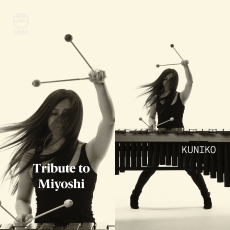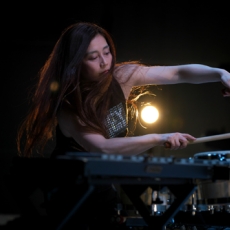KUNIKO - Tribute To Miyoshi [Live] - Mercure des Arts
Just as the term "Takemitsu Sound" is sometimes used to describe the music of Toru Takemitsu, I believe that there is something that should be called "Miyoshi Sound" in the music of Akira Miyoshi. However, if we consider "sound" to be the timbre or acoustics of various sounds combined simultaneously, it is difficult to create a "Miyoshi sound" on a solo instrument such as the marimba, which can only produce about four (or sometimes six) mallets simultaneously. In the hands of Kuniko Kato, however, the marimba's timbral sound gives the piece a "Miyoshi sound".
In the suite "Conversation", we heard a variety of music on a single marimba: "A gentle story", like the whispering of a child's secret; "I'm glad, that... again and again", with its lively jumping; "I'll always be sorry", with its fast tempo and exasperated marimba strikes; "All I can do is reply", with its pale rolls and clear passages; and "A report that doesn't add up", that runs away like a blur.
All four parts of "Torse III" were played without interruption, and the variety and precision of Kato's tone in each phrase, or rather each note, of the first "Thèse" was astonishing. The next piece, "Chant", was played with heavy mallets and weak rolls, with an unsettling atmosphere, as if we were walking in a fog. "Commentaire" is a marimba version of the "Miyoshi Sound", with its incredibly complex music, probably written in polyphonic writing. "Syntèse" is again a weak roll with heavy mallets, but then it suddenly rushes forward with hard and fast strikes, finally diminuendoing with a roll and disappearing. It's Akira Miyoshi all over again.
In the beginning of "Ripple", there is one centripetal pitch and the sound develops around it. Here too, Kato's versatility in volume and tone remains. In the middle part of the piece, chords with weak rolls are spun out quietly but mysteriously in a harmonic progression, then rhythmic music starts to be played in the lowest register, and the volume crescendos as the pitch rises to the end of the piece, which could be called a complex folk dance. Kato dances with shouts such as "Ya", "Huh!", "Ah!" The last part of the piece seemed to end on a very small note, but ended with a bouncing hard hit with a transitional Miyoshi sound.
From the beginning of "Etoiles à cordes" by Ensemble Nomae string members, the simultaneous Miyoshi sound reached our ears severely. Although the hall may have made Chiyoko Noguchi's sound a little weak, the cadenza, in which she cried out as if she were being torn apart by Nanimonoka, was a masterpiece, and I was stunned and overwhelmed by the world of Miyoshi, which was so concentrated that it was hard to believe that the work lasted less than ten minutes.
The final piece, "Concerto for Marimba and Strings", began with the marimba's rolls in the upper register and low strings sounding rather sinister, but more like Miyoshi. The marimba solo leads the strings into a transitional miyoshi sound (melody and accompaniment) with a simultaneous miyoshi sound (sound). After a brief period of dullness and depression, a phrase announcing the beginning of the Miyoshi Sound Fortissimo Presto was heard, and all instruments filled the hall with intense music. But then came the quiet but tense marimba solo, followed by the strings, and then the howling of all the instruments in the Miyoshi Sound Fortissimo Presto to end the piece.
The precise reading and reproduction of Miyoshi by Kuniko Kato and Ensemble Nomad created a sound that was at times strong and at other times delicate. It is not often that one encounters Akira Miyoshi of this calibre. Many thanks to all those involved in the concert.

